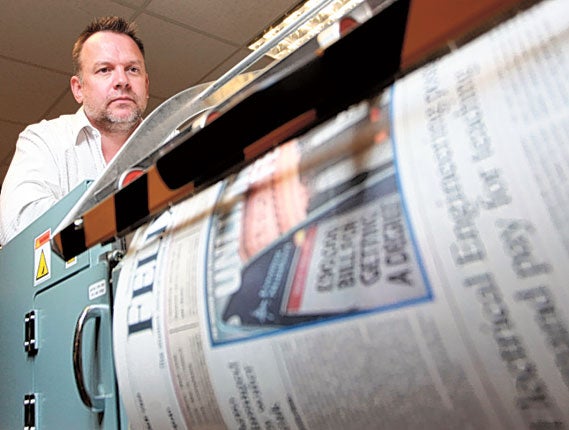More changes for print as digital offers newspapers to distant readers

Your support helps us to tell the story
From reproductive rights to climate change to Big Tech, The Independent is on the ground when the story is developing. Whether it's investigating the financials of Elon Musk's pro-Trump PAC or producing our latest documentary, 'The A Word', which shines a light on the American women fighting for reproductive rights, we know how important it is to parse out the facts from the messaging.
At such a critical moment in US history, we need reporters on the ground. Your donation allows us to keep sending journalists to speak to both sides of the story.
The Independent is trusted by Americans across the entire political spectrum. And unlike many other quality news outlets, we choose not to lock Americans out of our reporting and analysis with paywalls. We believe quality journalism should be available to everyone, paid for by those who can afford it.
Your support makes all the difference.There are big changes afoot in print media. This morning at the five-star Mandarin Oriental Hotel near London's Hyde Park, guests were able to take their breakfast with a selection of reading material that included such diverse newspapers as the Moscow Times, the Jerusalem Post and the China Daily, all published in their immediate editions, produced only minutes earlier on a printer near Heathrow airport.
Similar digital techniques were being used this morning in Dubai and Malta, to print directly from PDF files copies of British newspaper titles including the Daily Mail and the Daily Mirror so ex-pat readers can wake up to today's edition.
Digital technology developed by such companies as Océ and Kodak is enabling newspaper companies to cut out crippling distribution costs while still offering distant readers the tactile and visual pleasures of a physical newspaper. Publishers are excited by the opportunities for using small digital printers for locally producing British national titles both abroad and in remote corners of the United Kingdom without the use of long-distance transport.
"It's something that is very much in its juvenescence but is an exciting and interesting development," says Mark White, head of foreign circulation at Mirror Group Newspapers. "Lots of people are looking at it."
The challenge to this technology is whether it can be developed at such a rate that it can be a viable alternative to the increasingly rich applications publishers are developing for iPad and other tablets and mobile devices. News International, for example, said last week that 35,000 Times apps are being downloaded onto iPads every day, with the Sunday Times logging 31,000 downloads a week, up 41 per cent in four months.
In markets such as Spain where there is high demand for British papers, titles including the Sun and Mail use traditional printing plants. These facilities are costly. Guardian News & Media, which lost £33m last year, will shut its printing operations in New York, Frankfurt, Madrid, Malta and Cyprus from 1 October, to concentrate on non-print platforms "including our forthcoming launches on Kindle and iPad", reveals an internal email from GNM executive director Adam Freeman.
Even so, print is still the medium that sustains the national newspaper business and international sales are a crucial component of that revenue stream. But the cost of flying hard copies of papers around the world is becoming prohibitive. "As airlines come under more pressure for revenues, there are lots of charges that weren't there before," complains White. "There are escalating fuel costs but also things like X-raying copy, customs clearance, the security taxes that have come in since 9-11. All these things add up in the cost of pence per copies. And sometimes you are held hostage by things like volcanic ash clouds and your copies don't go anywhere for a week."
In a factory unit near Heathrow airport, Steve Brown, managing director of Stroma printers, now offers British distributors such as hotels, restaurants and embassies, a range of 1,500 international titles produced from that day's PDFs, supplied by the publishers. On a typical day he will supply 60 international titles on demand. "Since we have had the [colour] machine there is a lot more take-up from hotels and business delivery services. I think they found the black and white versions a bit underwhelming. They have now taken it up with both hands." The company has a deal with Qantas airlines to supply passengers with titles such as the Sydney Morning Herald printed from PDF. Australian titles formerly took a full day to arrive in Britain.
Mike Newman, a consultant to Associated Newspapers and former director of circulation at the Daily Mail's publisher, thinks the availabil- ity of full-colour digital printing offers "a lot of possibilities". He says: "It's just the electronic transmission of a PDF and you can print any newspaper in the world. I take the point about [the popularity of] iPads and tablets and they're going to grow but what we are doing is providing additional facilities. Based on the demand at the moment, a lot of people when they are travelling still like to get their hands on a newspaper."
He says the Newspaper Publishers Association, which represents the national press, hopes to bring digital printing to the Channel Islands. Other businesses are looking to set up similar services in the Shetland Islands. "The most expensive stretch of water that we all cross in the world is to the Channel Islands," says Newman. "It costs £100,000s a year to fly papers to the Channel Islands every day and we lose 10 per cent of days to technical failures by the aircraft or inclement weather such as fog."
Meanwhile in Switzerland, Swiss Post is developing a groundbreaking service that individually tailors a digitally printed newspaper to the preferences of readers, who complete a check list of their interests online.
The printed paper keeps evolving.
Join our commenting forum
Join thought-provoking conversations, follow other Independent readers and see their replies
Comments